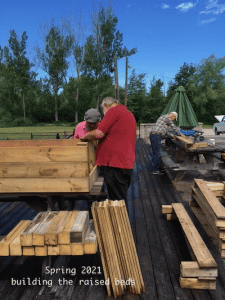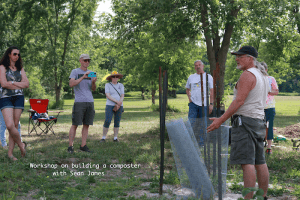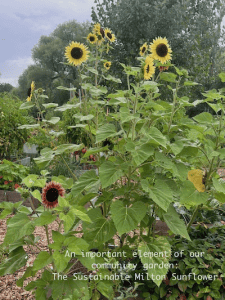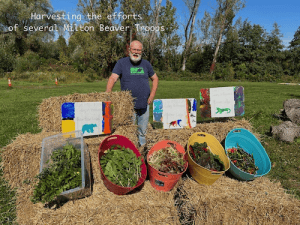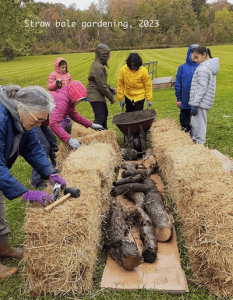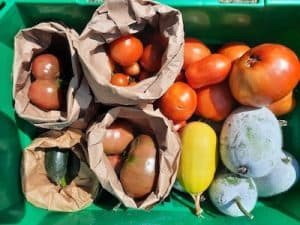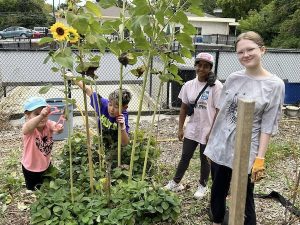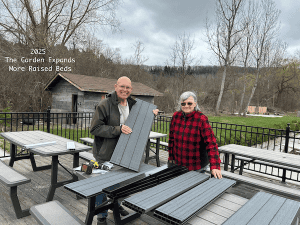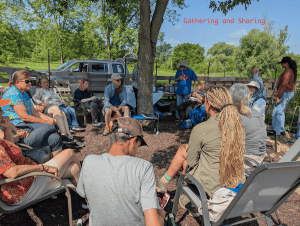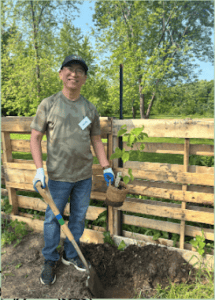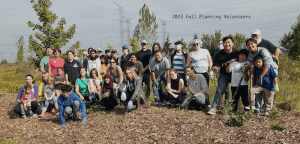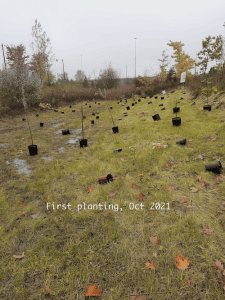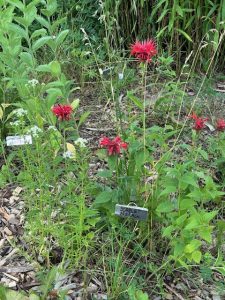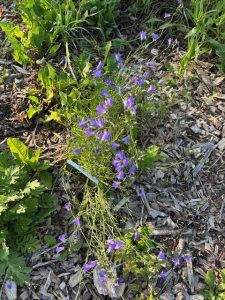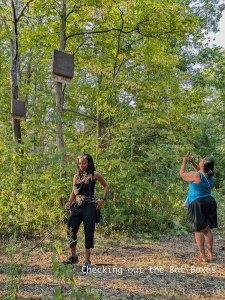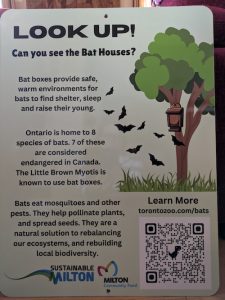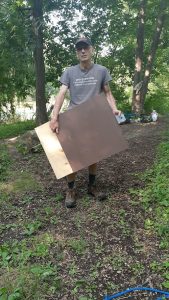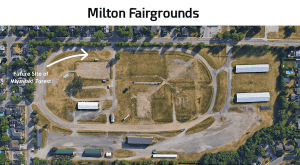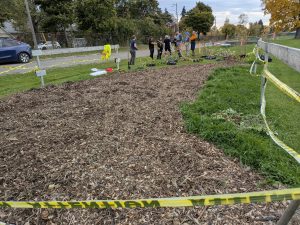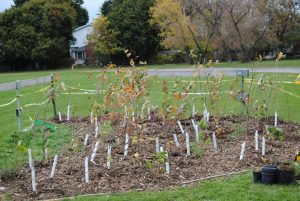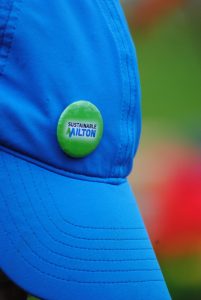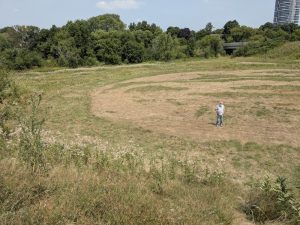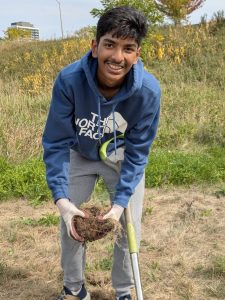Ongoing Projects
When planting perennials the saying is “1st year they sleep, 2nd year they creep and third year they leap.” Thus it is with most projects; it takes some time until progress is made. Sustainable Milton is currently in the midst of several ongoing projects around Milton: some barely visible, some nearing their maturity. The Community Garden at the ICCM was started 5 years ago and thus the harvest is plentiful, while ground breaking for the Miyawaki Forest at the Milton Fairgrounds will start this October. Check out these Ongoing Projects as they develop.
Community Garden at the ICCM
The community garden is a partnership between Sustainable Milton, the Italian Cultural Centre of Milton, and the Town of Milton. It’s located at the ICCM, 104 Tremaine Rd., Milton.
About
In May of 2021, the community garden at the Italian Cultural Centre of Milton (ICCM) was created with a grant from Landscape Ontario, with wood provided by the ICCM and by hardworking volunteers. We came together to build, plant and nurture 14 garden boxes.
Over the next three summers, we hosted an informal garden “drop-in” for youth and families. We learned from one another, had a lot of fun, and shared what we grew. Through the generosity of the Town, the ICCM and local gardeners, we were able to purchase garden tools and equipment, host speakers and conduct workshops. We learned how to build a composter and save seeds. A chef taught us how to roast beets, make pesto and hot sauce from our harvest. We learned about caring for the land and Mother Earth’s gifts through an Indigenous lens.
In the summer of 2025, with a grant from the Town of Milton and the federal government’s New Horizons for Seniors program, we were able to purchase additional tools and equipment, added eight accessible garden beds, and hired a Program Coordinator to deliver our “Growing Together Food Share” program four mornings a week.
Why
In our Community Garden, adults and youth, grandparents and their grandchildren, university and high school students – from diverse backgrounds and abilities – learned from one another, broke bread, painted and stretched together, savoured fresh produce, shared stories, recipes and laughter and, most of all, made connections. We continue to celebrate the community our little garden has grown.
Media
Check out the activities of our Community Garden through our social media channels and on our YouTube.
Roper Drive
This pollinator garden is a partnership between Sustainable Milton and the Town of Milton. It’s located along Roper Drive in Milton.
About
In October of 2021, the Town of Milton, Conservation Halton and Sustainable Milton planted trees along the northern stretch of Roper Drive. Over the next four years, we have held numerous planting days in which volunteers extended the initial area with native plants, shrubs and trees.
Why native plants?
Native Plants are crucial because they form the basis of the local ecology. Native plants support native insects, which in turn provide food for native birds and other wildlife. They assure biodiversity as they are adapted to local soil and climate conditions requiring less water and maintenance. Problems of insect pests, poor growth and disease are unlikely. In addition, they help mitigate climate change by storing carbon. By planting native species, you foster a healthier, more resilient local ecosystem, benefiting both wildlife and people.
Media
Check out the activities at Roper Drive through our social media channels and on our YouTube playlist. This garden has been recognized as an official Monarch Way Station by Monarch Watch. It is also a part of the Milton corridor of the Butterflyway Project, a volunteer-led movement bringing nature home to neighbourhoods, one butterfly-friendly garden at a time.
“Sustainable Milton’s involvement at Roper Drive Garden reflects our commitment to creating greener and more welcoming community spaces. I personally got involved because I wanted to contribute to a project that connects people with nature and fosters a sense of community through gardening. Over time, I’ve taken on the role of caretaker, organizing volunteer sessions where we focus on planting, weeding, seed collection, and maintaining the health of the garden. This project has been a rewarding way to bring people together, encourage learning, and highlight the positive impact small green spaces can have in our town.”
– Aniqa Aamir, lead of the Roper Drive Crew
Indian Creek Trail
Caring for the Indian Creek Trail is a partnership between Sustainable Milton and the Town of Milton. The trail begins on the south side of Main Street across from Sherwood Community Centre, and runs south past Scott Neighbourhood Pond and ends at Derry Road. The north end of this trail has a woodlot, a pond, and meadow space.
About
This woodchip walking trail is a hidden treasure in the northwest corner of Milton. As adoptees of this trail, Sustainable Milton organizes Spring and Fall cleanups and community plantings to support the diversity of native species. As you walk down the path toward the pond, take a moment to look up and you’ll spot two bat houses that were installed in 2024 to help provide additional habitat for the local bat population.
Naturalizing this area will make it more resilient to the effects of climate change, promote native insects, improve soil quality and make the area easier to sustain and maintain.
Events
Events include guided walks and native species planting. Cleanups every spring and fall. Look for events at sustainablemilton.ca or follow us on Instagram, Bluesky or Facebook.
Media
You can follow Sustainable Milton’s activities at Indian Creek Trail through our social media channels or on YouTube.
How can you help?
Please help keep Milton trails clean and report problems to the town. Join us during community cleanup events or attend a guided walk.
Bat Boxes at Indian Creek Trail
The bat boxes at Indian Creek are a partnership between, Sustainable Milton, the Town of Milton, and EcoClub of Craig Kielburger Secondary School. We have found six sites for the bat homes built by the Craig Kielburger students. Two are at the Italian Cultural Centre on Tremaine Road, two are along the Indian Creek Trail, across Main St. from the Sherwood Community Centre, and two are on private land.
About
A major reason for the decline of bats is the loss of habitat. One way to help is to install a bat house. A bat house is a shelter where bats can roost during the day.
Bats are a keystone species, without them the ecology of the local area cannot thrive. They play an essential role in pest control, pollinating plants and dispersing seeds. Bats native to Canada are major predators of forest and agricultural pests and are a vital part of healthy ecosystems. While many people fear bats, in reality we need the ecosystem services provided by bats and in turn bats need our help to reduce threats to their populations.
When to spot bats
Bats sleep during the day and come out at dusk to feed. If you look at a piece of sky between trees in the woods you may see them performing their aerobatics as they gobble up their own weight in insects.
Media
Check out the Bat Boxes project on our YouTube channel.
How can you help?
Tell people that bats are a keystone species, and help them understand how important they are to our well-being, the economy, and the environment.
Miyawaki Forest
This mini-forest is a partnership between Sustainable Milton, the Halton Agricultural Society, and Conservation Halton. It’s located on the Milton Fair Grounds.
About
Originally developed by Japanese ecologist Akira Miyawaki in the early 1970s, a Miyawaki Forest is a layered mini forest designed to maximize ecological impact in a small space. This demonstration project will take up only 30 square meters, and will take place Fall 2025. Look for events on our website or Instagram, Facebook, or Bluesky.
Benefits of Miyawaki Forests:
- Carbon Capture: these forests store carbon above and below ground.
- Self-Sustaining: after just a few years, they need no irrigation and little maintenance.
- Adds shade.
- Improves air quality by absorbing harmful pollutants such as nitrogen dioxide and sulphur dioxide.
- Improves soil quality by supporting the rapid growth of beneficial soil fungi.
- Biodiversity Boosters: native plants support pollinators, birds, and soil life.
- Pocket forests grow like a 100-year-old forest, in just 15 years.
What can you do?
Promote biodiversity in your own garden – prioritize native plants.
Media
You can follow the development of this project on our social media channels and the Miyawaki Playlist on our YouTube channel. For more information on Miyawaki Forests and pocket forests
Butterfly Meadow
This pollinator garden is a partnership between Sustainable Milton, the Canadian Wildlife Federation, Conservation Halton, 407ETR, Monarch Butterfly Eclipse Project, and the Town of Milton. It’s located at the corner of Commercial Street and Laurier Avenue, Milton.
About
The butterfly meadow is a feeding and habitat meadow for Monarch butterflies and other pollinator insects. The meadow will be shaped like a Monarch butterfly. Planting is taking place in Fall 2025. Teams will meet regularly to weed and care for the meadow.
Why a Monarch habitat?
Monarchs need our help! In December of 2023, the federal government formally listed the Monarch Butterfly as Endangered. The Canadian Wildlife Federation (CWF) supports the creation and restoration of breeding and feeding habitats for Monarch Butterflies in effort to halt the decline of the populations of these colourful iconic pollinators.
The Monarch is a summer breeder here in Milton and elsewhere in southern Ontario. Most of the Canadian-born adult Monarchs head to central Mexico to overwinter. It takes three to four generations of Monarchs to return to Canada during the spring migration. Monarchs require both milkweed (the host plant of the Monarch caterpillar) and other wildflowers (a source of nectar) to survive.
It isn’t just about Monarchs! Where Monarchs go, other pollinators follow. Monarchs are considered an umbrella species for other pollinators. Our meadow will also provide feeding and nesting habitat for many other pollinators and meadow species, not just Monarchs.
Media
Follow the progress of the Butterfly Meadow on our social media channels and the Butterfly Meadow playlist on YouTube.
How can you help?
Volunteers will be needed to help maintain the meadow. Visit our website for details.


